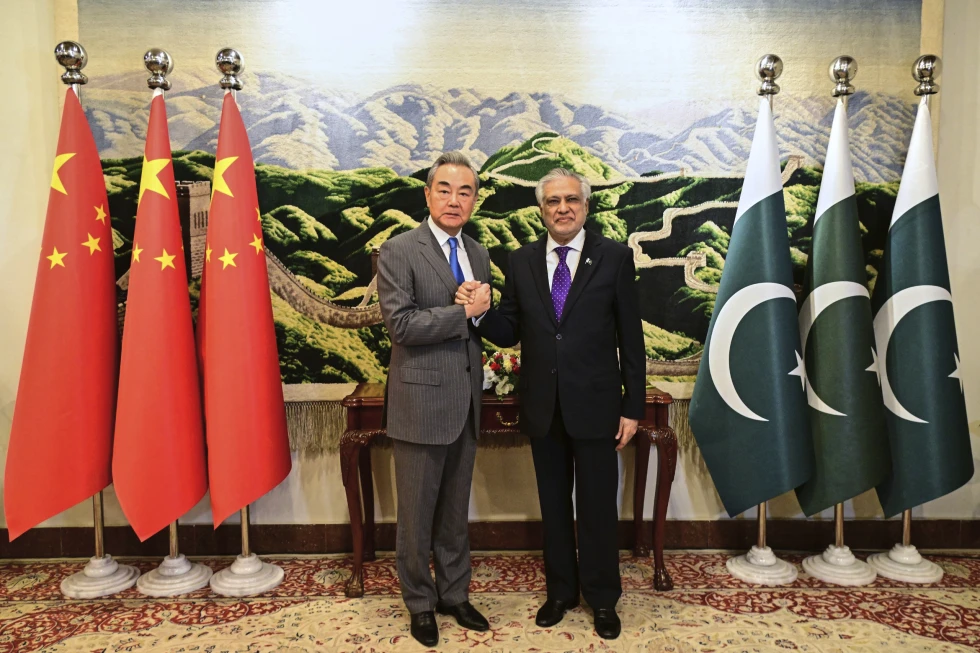CPEC-II or Charm Offensive? Pakistans Tightrope Diplomacy
By Hassaan Ahmad Awan

CPEC-II or Charm Offensive? Pakistan’s Tightrope Diplomacy
Introduction
Pakistan’s foreign policy has always been a reflection of its geography, security needs, and shifting global currents. In 2025, the country once again finds itself at a diplomatic crossroads. The revival of the China-Pakistan Economic Corridor (CPEC-II), recalibrated relations with Washington, and a new wave of regional diplomacy highlight the evolving contours of Islamabad’s strategy. But beneath the announcements and photo-ops lies a deeper challenge: how to balance reliance on China while keeping doors open to the United States and neighboring states.
CPEC-II: Old Wine in a New Bottle or Strategic Revival?
When CPEC was launched in 2015, it was framed as a “game-changer.” Billions of dollars in investment flowed toward roads, energy plants, and port infrastructure, particularly Gwadar. A decade later, however, the initiative faces mixed reviews. Critics argue that debt burdens and governance gaps diluted its promised benefits.
CPEC-II, rebranded and relaunched in 2025, is meant to correct course. Unlike the earlier focus on power plants and highways, this phase emphasizes industrial cooperation, digital connectivity, and green energy. Special Economic Zones (SEZs) are at the heart of this vision, with the hope that manufacturing clusters can absorb Pakistan’s youth bulge.
Yet questions remain. Can Pakistan provide the political stability, regulatory framework, and security that investors demand? Or will this new chapter face the same bottlenecks as before?
China’s Expanding Footprint
China remains Pakistan’s “all-weather friend,” but the relationship is far from static. Beijing’s ambitions through the Belt and Road Initiative (BRI) have shifted toward a more cautious approach, seeking sustainability and returns rather than grand symbolism.
For Pakistan, this means stricter scrutiny. Chinese companies now demand guarantees for profitability and faster dispute resolution. The Gwadar Port project, for instance, remains underutilized despite years of investment.
Security is another concern. Repeated attacks on Chinese nationals in Pakistan have strained trust. Beijing has pressed Islamabad to strengthen protection measures, often tying security guarantees directly to investment deals. This dynamic reveals the asymmetry of the partnership: while Pakistan needs capital, China seeks control and safety.
The Subtle US Re-engagement
While China dominates headlines, Washington has quietly re-entered Pakistan’s diplomatic orbit. Unlike the transactional nature of past ties—centered on security assistance during the Cold War or the War on Terror—the new American approach is subtler.
US engagement now emphasizes climate cooperation, tech partnerships, and regional connectivity. The Biden administration has signaled cautious support for Pakistan’s role in stabilizing Afghanistan, but without committing to large-scale aid. At the same time, Washington views CPEC with suspicion, seeing it as a lever of Chinese influence.
Pakistan’s policymakers, however, appear keen to avoid old binaries. The outreach toward the US is not about abandoning China, but about diversifying partners. A tightrope is being walked: securing economic cooperation with Beijing while extracting strategic breathing space from Washington.
Regional Diplomacy: A Delicate Chessboard
Beyond the superpowers, Pakistan is recalibrating its immediate neighborhood ties.
-
Afghanistan: The Taliban-led government continues to test Islamabad’s patience with cross-border militancy and trade disputes. Yet Pakistan cannot afford open hostility; it needs Kabul’s cooperation to keep western borders stable.
-
Iran: Pakistan has shown interest in expanding energy cooperation with Tehran despite US sanctions. The gas pipeline project, frozen for years, is back on the table amid rising domestic energy demand.
-
Gulf States: Saudi Arabia and the UAE remain crucial for remittances and bailouts. Recent high-level visits indicate Pakistan is willing to trade diplomatic support for financial assistance.
-
India: Tensions remain high, but subtle backchannel efforts suggest Islamabad recognizes that perpetual hostility limits its global standing.
This regional balancing act reflects a recognition: Pakistan’s foreign policy can no longer hinge solely on great power competition. Its neighborhood matters too.
Domestic Drivers of Diplomacy
Foreign policy does not exist in a vacuum. Domestic crises—from economic stagnation to political volatility—directly shape Pakistan’s external posture. The government hopes that CPEC-II can generate jobs and stabilize growth. Simultaneously, foreign engagement is used as a political tool to demonstrate competence at home.
However, the public is more skeptical. Memories of unfulfilled promises from the first CPEC phase linger, while inflation and unemployment create frustration. If tangible benefits do not materialize, no amount of diplomatic charm will sustain foreign partnerships.
Balancing Act or Tightrope Walk?
Pakistan’s current strategy could be described as “multi-alignment.” The aim is not to replace China with the US or vice versa, but to extract benefits from both without being trapped in their rivalry. This approach mirrors strategies adopted by other middle powers in Asia, such as Vietnam and Indonesia, which engage both Washington and Beijing simultaneously.
The danger, however, lies in overestimating Pakistan’s leverage. Unlike those Southeast Asian states, Pakistan’s economic fundamentals are weaker, making it more vulnerable to external pressure. For the tightrope walk to succeed, Islamabad will need reforms at home: improved governance, transparency in contracts, and credible security guarantees.
Conclusion: A Chance for Pragmatic Realignment
CPEC-II and Pakistan’s evolving diplomacy highlight both risk and opportunity. If managed wisely, Islamabad can transform geography into advantage—linking Chinese capital, American technology, Gulf remittances, and regional trade into a sustainable growth strategy. If mismanaged, however, Pakistan risks being caught in great power crossfire while alienating its neighbors.
The tightrope diplomacy of 2025 is not just about balance. It is about survival in a world where old alliances no longer guarantee security or prosperity.
✍️ By Hassaan Ahmad Awan
Writer, columnist, and blogger.
At hassaanahmadawan.com, I analyze Pakistan’s politics, society, environment, and global affairs with a focus on depth and clarity.
Urdu Version Of Column:
سی پیک-ٹو یا دلکشی کی مہم؟ پاکستان کی تنی ہوئی سفارت کاری
پاکستان کی خارجہ پالیسی ایک ایسے دوراہے پر کھڑی ہے جہاں پرانی انحصاریوں اور نئی حقیقتوں کے درمیان توازن قائم کرنا ناگزیر ہے۔ چین کے ساتھ سی پیک دوم (CPEC-II) کے ذریعے تعلقات کی توسیع اور خطے میں نئی سفارت کاری کی کاوشیں پاکستان کے لیے مواقع اور خطرات دونوں لاتی ہیں۔ ساتھ ہی امریکہ کی طرف بڑھتے نرم قدم یہ عندیہ دیتے ہیں کہ اسلام آباد اپنی خارجہ حکمتِ عملی میں تنوع پیدا کرنے کی جستجو کر رہا ہے۔ لیکن یہ کشمکش پاکستان کی کمزور معیشت، قرضوں کی دلدل اور اندرونی سیاسی بے یقینی کے درمیان کیسے آگے بڑھے گی، یہی اصل سوال ہے۔
چین پر انحصار اور سی پیک دوم کا تناظر
چین کے ساتھ پاکستان کا تعلق دہائیوں پر محیط ہے، لیکن چین-پاکستان اقتصادی راہداری (CPEC) نے اسے نئی جہت دی۔ پہلے مرحلے میں بنیادی ڈھانچے، توانائی اور مواصلاتی منصوبوں نے چین کو پاکستان کے ترقیاتی عمل میں مرکزی حیثیت دی۔ اب سی پیک دوم (CPEC-II) کے تحت صنعتی زونز، زراعت اور ٹیکنالوجی کے شعبوں میں سرمایہ کاری پر توجہ دی جا رہی ہے۔
یہ پاکستان کے لیے ایک طرف ترقی کے مواقع ہیں لیکن دوسری جانب یہ خدشات بھی جنم لیتے ہیں کہ کہیں زیادہ انحصار معاشی خودمختاری کو محدود نہ کر دے۔ عالمی سطح پر چین کی ابھرتی ہوئی طاقت اور مغرب کے ساتھ اس کے بڑھتے تنازعات پاکستان کو دباؤ میں لا سکتے ہیں۔
نئی علاقائی سفارت کاری کی ضرورت
افغانستان میں طالبان کی واپسی کے بعد خطے کا توازن بدل گیا ہے۔ پاکستان کو وسطی ایشیا تک اقتصادی روابط بڑھانے کا موقع ملا ہے لیکن ساتھ ہی سلامتی کے خدشات بھی بڑھے ہیں۔ بھارت کے ساتھ تعلقات مسلسل کشیدگی کا شکار ہیں، تاہم خلیج ممالک کے ساتھ بڑھتی معاشی شراکت اور ایران کے ساتھ ممکنہ تجارتی امکانات پاکستان کے لیے نئے امکانات پیدا کر سکتے ہیں۔
اسی پس منظر میں پاکستان حالیہ برسوں میں وسطی ایشیائی ممالک کے ساتھ تجارتی راہداریوں اور گوادر بندرگاہ کو خطے کے حب کے طور پر پیش کرنے پر زور دے رہا ہے۔ لیکن ان سب کے لیے داخلی سیاسی استحکام اور سیکیورٹی کا مضبوط ڈھانچہ بنیادی شرط ہے۔
امریکہ کی طرف نرم جھکاؤ
پاکستان اور امریکہ کے تعلقات ہمیشہ اونچ نیچ کا شکار رہے ہیں۔ انسدادِ دہشت گردی کے دور کے بعد اعتماد میں کمی واقع ہوئی، لیکن حالیہ برسوں میں ایک نیا نرم پن دیکھا جا رہا ہے۔ امریکہ پاکستان میں براہِ راست سرمایہ کاری پر بات کر رہا ہے اور ٹیکنالوجی و توانائی کے شعبوں میں تعاون بڑھانے کے اشارے دے رہا ہے۔
یہ رویہ پاکستان کی حکمتِ عملی میں ایک توازن پیدا کرنے کی کوشش ہے تاکہ وہ صرف چین پر انحصار نہ کرے بلکہ مغربی دنیا کے ساتھ بھی اپنی شراکت داری کو زندہ رکھ سکے۔ تاہم اس توازن کو قائم رکھنا ایک کٹھن عمل ہے کیونکہ امریکہ اور چین کی عالمی رقابت مسلسل شدت اختیار کر رہی ہے۔
سفارتی رسہ کشی میں پاکستان کی مشکلات
پاکستان کو خارجہ پالیسی کے اس تنوع میں کئی مشکلات کا سامنا ہے:
-
معاشی دباؤ: قرضوں کی ادائیگی، ڈالر کی قلت اور آئی ایم ایف پروگرام پر انحصار پاکستان کے فیصلوں کو محدود کر دیتے ہیں۔
-
داخلی سیاسی بحران: حکومتوں کی بار بار تبدیلی اور ادارہ جاتی کشمکش ایک مستقل خارجہ پالیسی کی راہ میں رکاوٹ ہیں۔
-
سلامتی چیلنجز: سرحدی تنازعات، دہشت گردی کی نئی لہر اور بھارت کے ساتھ تعلقات سفارتی چالاکیوں کو محدود کرتے ہیں۔
-
عالمی دباؤ: امریکہ-چین کشمکش، روس-یوکرین جنگ اور مشرق وسطیٰ کے تنازعات پاکستان کے لیے انتخاب کو مزید مشکل بنا دیتے ہیں۔
مستقبل کا راستہ: متوازن حکمت عملی
پاکستان کو نہ صرف چین کے ساتھ اپنے تعلقات کو اقتصادی ترقی اور توانائی کے مواقع کے لیے بڑھانا ہوگا بلکہ امریکہ اور یورپ کے ساتھ سرمایہ کاری اور ٹیکنالوجی تعاون کو بھی فروغ دینا ہوگا۔ اسی طرح خلیج، ایران اور وسطی ایشیا کے ساتھ تجارتی روابط پاکستان کے لیے ایک متبادل راستہ فراہم کر سکتے ہیں۔
ایک کثیر جہتی خارجہ پالیسی ہی پاکستان کو عالمی نظام میں جگہ دلا سکتی ہے، بشرطیکہ وہ اندرونی سطح پر معاشی اصلاحات اور سیاسی استحکام لا سکے۔
نتیجہ
پاکستان کی خارجہ پالیسی آج ایک تنی ہوئی رسی پر چلنے والے کرتب باز کی مانند ہے۔ ایک طرف چین کے ساتھ قریبی تعلقات ہیں جو ترقی کے مواقع دیتے ہیں، دوسری طرف امریکہ اور مغربی دنیا سے تعلقات کو مکمل طور پر نظر انداز کرنا ممکن نہیں۔ خطے میں نئے تعلقات بنانے اور پرانے تنازعات کو سنبھالنے کی صلاحیت ہی طے کرے گی کہ پاکستان آئندہ برسوں میں کس سمت میں جائے گا۔
✍️ مصنف کا تعارف:
میں، حسّان احمد اعوان، ایک مصنف، استاد اور بلاگر ہوں جو پاکستان کی سیاست، تاریخ، معاشرت اور ماحول پر تحقیقی و تجزیاتی کالم لکھتا ہوں۔ میری تحریروں کا مقصد نہ صرف خبروں کو سمجھنا بلکہ پسِ منظر اور مستقبل کی سمت کو قارئین کے سامنے لانا ہے۔
FAQs :
Q1. What is CPEC-II and how does it differ from the original CPEC?
CPEC-II is considered the second phase of the China-Pakistan Economic Corridor, focusing on industrial zones, agriculture, and digital cooperation, whereas the first phase was largely about infrastructure and energy projects.
Q2. How is Pakistan balancing relations between China and the United States?
Pakistan is attempting a tightrope diplomacy—deepening ties with China through CPEC-II while simultaneously re-engaging with the US for trade, technology, and geopolitical balance.
Q3. Why is regional diplomacy important for Pakistan’s foreign policy?
Regional diplomacy allows Pakistan to secure economic and security partnerships with neighbors like Iran, Afghanistan, and Central Asian states, reducing overreliance on any single power.
Q4. What challenges does Pakistan face in maintaining balanced foreign relations?
Challenges include economic dependency, shifting global power blocs, pressure from Western allies, and the need to maintain sovereignty while accepting foreign investments.
Q5. Can Pakistan use CPEC-II as leverage in its diplomacy with the US?
Yes, Pakistan can strategically use progress in CPEC-II as leverage to negotiate technology transfers, investment, and broader engagement with the US.


